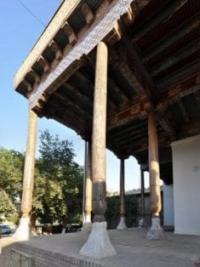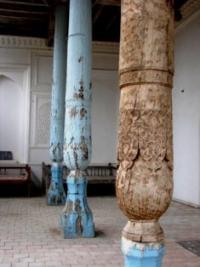You are here
Wood painting in Samarkand.


Tours on architectural monuments in vicinities of Samarkand.
“Does progress mean that we dissolve our ancient myths? If we forget our legends, I fear that we shall close an important door to the imagination”
James Christensen.
Travel advisory in Samarkand.
External verandahs "aivans" always played an important role in decor of a mosque and were of especial interest of national architects. Just aivans and adjoining areas served a place where the majority of prayers prayed.
Actually, a form and decor of aivans determined appearance of any mosque. Therefore, they were richly decorated, including columns and ceilings. The major expressive mean of the Samarkand school became polychromic wood painting.
It represents a field of general tradition of wood painting, which has spread further through Fergana and Eastern Turkistan to China. In Samarkand, massive carved wooden columns were painted colourfully from a plinth up to a capital.
Green and white zigzags form a characteristic pattern of Samarkand columns. Multilevel wooden ceilings of mosques demonstrate especially rich decor. According to a distance between columns and location of beams, a ceiling was divided into rectangular sectors. As a rule, it is formed from "vassa" - sets of semicircular planks.
The most typical is "vassa", painted in green and red with a pattern of cross-shaped petal. Obligatory colours are gold, dark blue and white. The paintings often include weaving vegetative patterns with numerous spires and exquisite flowers as well as geometric ornament, often with the ancient symbol of "swastika".
Besides "vassa", there are wooden carved ceilings with geometric star-shaped patterns.
Authority:
Alexey Arapov. Samarkand. Masterpieces of Central Asia. Tashkent, Sanat. 2004.







